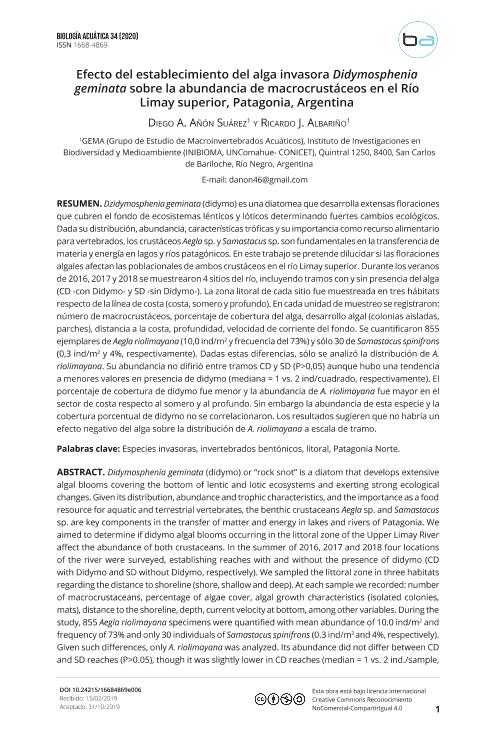Mostrar el registro sencillo del ítem
dc.contributor.author
Añón Suárez, Diego Alejandro

dc.contributor.author
Albariño, Ricardo Javier

dc.date.available
2023-08-17T13:32:23Z
dc.date.issued
2020-02
dc.identifier.citation
Añón Suárez, Diego Alejandro; Albariño, Ricardo Javier; Efecto del establecimiento del alga invasora Didymosphenia geminata sobre la abundancia de macrocrustáceos en el Río Limay superior, Patagonia, Argentina; Consejo Nacional de Investigaciones Científicas y Técnicas. Centro Científico Tecnológico Conicet - La Plata. Instituto de Limnología "Dr. Raúl A. Ringuelet"; Biología Acuática; 34; 2-2020; 1-12
dc.identifier.issn
1668-4869
dc.identifier.uri
http://hdl.handle.net/11336/208588
dc.description.abstract
Dzidymosphenia geminata (didymo) es una diatomea que desarrolla extensas floraciones que cubren el fondo de ecosistemas lénticos y lóticos determinando fuertes cambios ecológicos. Dada su distribución, abundancia, características tróficas y su importancia como recurso alimentario para vertebrados, los crustáceos Aegla sp. y Samastacus sp. son fundamentales en la transferencia de materia y energía en lagos y ríos patagónicos. En este trabajo se pretende dilucidar si las floraciones algales afectan las poblacionales de ambos crustáceos en el río Limay superior. Durante los veranos de 2016, 2017 y 2018 se muestrearon 4 sitios del río, incluyendo tramos con y sin presencia del alga (CD -con Didymo- y SD -sin Didymo-). La zona litoral de cada sitio fue muestreada en tres hábitats respecto de la línea de costa (costa, somero y profundo). En cada unidad de muestreo se registraron: número de macrocrustáceos, porcentaje de cobertura del alga, desarrollo algal (colonias aisladas, parches), distancia a la costa, profundidad, velocidad de corriente del fondo. Se cuantificaron 855 ejemplares de Aegla riolimayana (10,0 ind/m2 y frecuencia del 73%) y sólo 30 de Samastacus spinifrons (0,3 ind/m2 y 4%, respectivamente). Dadas estas diferencias, sólo se analizó la distribución de A. riolimayana. Su abundancia no difirió entre tramos CD y SD (P>0,05) aunque hubo una tendencia a menores valores en presencia de didymo (mediana = 1 vs. 2 ind/cuadrado, respectivamente). El porcentaje de cobertura de didymo fue menor y la abundancia de A. riolimayana fue mayor en el sector de costa respecto al somero y al profundo. Sin embargo la abundancia de esta especie y la cobertura porcentual de didymo no se correlacionaron. Los resultados sugieren que no habría un efecto negativo del alga sobre la distribución de A. riolimayana a escala de tramo.
dc.description.abstract
Didymosphenia geminata (didymo) or “rock snot” is a diatom that develops extensive algal blooms covering the bottom of lentic and lotic ecosystems and exerting strong ecological changes. Given its distribution, abundance and trophic characteristics, and the importance as a food resource for aquatic and terrestrial vertebrates, the benthic crustaceans Aegla sp. and Samastacus sp. are key components in the transfer of matter and energy in lakes and rivers of Patagonia. We aimed to determine if didymo algal blooms occurring in the littoral zone of the Upper Limay River affect the abundance of both crustaceans. In the summer of 2016, 2017 and 2018 four locations of the river were surveyed, establishing reaches with and without the presence of didymo (CD with Didymo and SD without Didymo, respectively). We sampled the littoral zone in three habitats regarding the distance to shoreline (shore, shallow and deep). At each sample we recorded: number of macrocrustaceans, percentage of algae cover, algal growth characteristics (isolated colonies, mats), distance to the shoreline, depth, current velocity at bottom, among other variables. During the study, 855 Aegla riolimayana specimens were quantified with mean abundance of 10.0 ind/m2 and frequency of 73% and only 30 individuals of Samastacus spinifrons (0.3 ind/m2 and 4%, respectively). Given such differences, only A. riolimayana was analyzed. Its abundance did not differ between CD and SD reaches (P>0.05), though it was slightly lower in CD reaches (median = 1 vs. 2 ind./sample, respectively). Percent didymo cover was lower and A. riolimayana abundance was higher at shore compared to shallow and deep sectors. However, A. riolimayana abundance and percent didymo cover did not correlate suggesting that at the reach scale there is no negative effect of didymo on the abundance and distribution of A. riolimayana.
dc.format
application/pdf
dc.language.iso
spa
dc.publisher
Consejo Nacional de Investigaciones Científicas y Técnicas. Centro Científico Tecnológico Conicet - La Plata. Instituto de Limnología "Dr. Raúl A. Ringuelet"
dc.rights
info:eu-repo/semantics/openAccess
dc.rights.uri
https://creativecommons.org/licenses/by-nc-sa/2.5/ar/
dc.subject
Especies invasoras
dc.subject
Invertebrados bentónicos
dc.subject
Litoral
dc.subject
Patagonia Norte
dc.subject.classification
Conservación de la Biodiversidad

dc.subject.classification
Ciencias Biológicas

dc.subject.classification
CIENCIAS NATURALES Y EXACTAS

dc.title
Efecto del establecimiento del alga invasora Didymosphenia geminata sobre la abundancia de macrocrustáceos en el Río Limay superior, Patagonia, Argentina
dc.type
info:eu-repo/semantics/article
dc.type
info:ar-repo/semantics/artículo
dc.type
info:eu-repo/semantics/publishedVersion
dc.date.updated
2021-01-27T19:54:14Z
dc.journal.number
34
dc.journal.pagination
1-12
dc.journal.pais
Argentina

dc.journal.ciudad
La Plata
dc.description.fil
Fil: Añón Suárez, Diego Alejandro. Universidad Nacional del Comahue. Centro Regional Universidad Bariloche. Departamento de Zoología; Argentina
dc.description.fil
Fil: Albariño, Ricardo Javier. Consejo Nacional de Investigaciones Científicas y Técnicas. Centro Científico Tecnológico Conicet - Patagonia Norte. Instituto de Investigaciones en Biodiversidad y Medioambiente. Universidad Nacional del Comahue. Centro Regional Universidad Bariloche. Instituto de Investigaciones en Biodiversidad y Medioambiente; Argentina
dc.journal.title
Biología Acuática
dc.relation.alternativeid
info:eu-repo/semantics/altIdentifier/url/https://revistas.unlp.edu.ar/bacuatica/article/view/16684869e006
dc.relation.alternativeid
info:eu-repo/semantics/altIdentifier/doi/https://doi.org/10.24215/16684869e006
Archivos asociados
